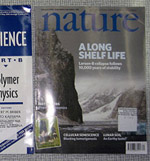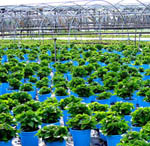New conservation books: February 2010 revue
In the Conservation Book Revue, we profile the latest conservation books that have been published in the past month or so. Our goal is to keep you updated about the newest titles being published int the world of conservation. Happy reading!
1) Conservation Biology for All, Oxford University Press
 Edited by Navjot S. Sodhi and Paul R. Ehrlich
Edited by Navjot S. Sodhi and Paul R. Ehrlich
February 2010 | 400 pp. | 9.7 x 7.3 in
Find online ($61 and up)
Publisher's Description: Conservation Biology for All provides cutting-edge but basic conservation science to a global readership. A series of authoritative chapters have been written by the top names in conservation biology with the principal aim of disseminating cutting-edge conservation knowledge as widely as possible. Important topics such as balancing conversion and human needs, climate change, conservation planning, designing and analyzing conservation research, ecosystem services, endangered species management, extinctions, fire, habitat loss, and invasive species are covered. Numerous textboxes describing additional relevant material or case studies are also included.
2) Coyote at the Kitchen Door: Living with wildlife in suburbia, Harvard Press
 Stephen DeStefano
Stephen DeStefano
January 2010 | 224 pp. | 8.3 x 5.7 in
Find online ($ 16 and up)
Publisher's Description: In Coyote at the Kitchen Door, Stephen DeStefano draws on decades of experience as a biologist and conservationist to examine the interplay between urban sprawl and wayward wildlife. Woven throughout the book is the story of one of the most successful species in North America: the coyote. Once restricted to the prairies of the West, this adaptable animal now inhabits most of North America—urban and wild alike. DeStefano traces a female coyote’s movements along a winding path between landscapes in which her species learned to survive and flourish. Coyote at the Kitchen Door asks us to rethink the meaning of progress and create a new suburban wildlife ethic.
3) The Encyclopedia of Weather and Climate Change, University of California Press
 Juliane L. Fry, Hans-F Graf, Richard Grotjahn, Marilyn N. Raphael, Clive Saunders, and Richard Whitaker
Juliane L. Fry, Hans-F Graf, Richard Grotjahn, Marilyn N. Raphael, Clive Saunders, and Richard Whitaker
February 2010 | 512 pp. | 10.8 x 9.5 in | 2700 color illustrations, 780 maps, 50 tables
Find online ($26 and up)
Publisher's Description: This beautiful, comprehensive, and up-to-date volume covers in amazing depth all aspects of the world's weather. Liberally illustrated with more than 2,000 color photographs, supplemental maps, diagrams, and other images, The Encyclopedia of Weather and Climate Change takes the reader beyond simple definitions to explore where weather comes from and the roles played by oceans and water cycles, and explains such related phenomena as the shaping of landforms, the creation of biological provinces, and the lasting ramifications of climate change. It also discusses how humans have survived and adapted in extreme climates like deserts, jungles, and icy regions. Each of the book's six sections is written and vetted by a different expert.
4) Tigers of the World: the Science, Politics, and Conservation of Panthera Tigris
 edited by Ronald Tilson and Philip Nyhus
edited by Ronald Tilson and Philip Nyhus
January 2010 | 552 pp. | 9.4 x 7.3 in
Find online ($80 and up)
Publisher's Description: The second edition of Tigers of the World explores tiger biology, ecology, conservation, management, and the science and technology that make this possible. In 1988 when the first edition was published, tiger conservation was still in its infancy, and two decades later there has been a revolution not only in what is known, but how information about tigers is obtained and disseminated. In the fast changing world of conservation there is a great need to summarize the vast and current state-of-the-art, to put this into historical perspective, and to speculate in what yet remains to be done.
Tigers of the World, 2nd Edition fulfills this need by bringing together in a unique way the world’s leading tiger experts into one volume. Despite the challenges ahead, there are bright spots in this story, and lessons aplenty not only for tiger specialists but large carnivore specialists, conservation biologists, wildlife managers, natural resource policy makers, and most importantly the caring public.
5) Wild Rangelands: Conserving Wildlife while Maintaining Livestock in Semi-Arid Ecosystems, Wiley
 edited by Johan du Toit, Richard Kock, James Deutsch
edited by Johan du Toit, Richard Kock, James Deutsch
February 2010 | 448 pp. | 9.1 x 6.1 in
Find online ($66 and up)
Publisher's Description: This book examines the pressures on rangeland ecosystems worldwide from human land use, over-hunting, and subsistence and commercial farming of livestock and crops. Leading experts have pooled their experiences from all continents to cover the ecological, sociological, political, veterinary, and economic aspects of rangeland management today. This book provides practitioners and students of rangeland management and wildland conservation with a diversity of perspectives on a central question: can rangelands be wildlands?
6) Conservation of Shared Environments: Learning from the United States and Mexico University of Arizona Press
 Edited by Laura López-Hoffman; Emily D. McGovern; Robert G. Varady; Karl W. Flessa
Edited by Laura López-Hoffman; Emily D. McGovern; Robert G. Varady; Karl W. Flessa
December 2009 | 296 pp. | 8.9 x 6 in
Find online ($25 and up)
Publisher's Description: The United States and Mexico’s shared environment extends far beyond the political line. For instance, it comprises the plant and animal species whose natural distributions extend deep into each nation along with the waters in rivers and aquifers that support ecosystem function far removed from the border. Conservation of Shared Environments presents a broad perspective on the ecological, social and political challenges of conserving biodiversity across the U.S.-Mexico border. Covering topics as diverse as wildlife and grassland preservation, water rights, ecosystem services, indigenous peoples, and the ecological consequences of border security, the contributors illustrate collaborative, transboundary efforts to overcome cross-border conservation challenges. This volume offers scientific analysis as well as insight for bridging gaps between researchers, policymakers, and the public.
7) Explaining Research: How to reach key audiences to advance your work, Oxford University Press
 Dennis Meredith
Dennis Meredith
February 2010 | 376 pp. | 9.1 x 6.1 in
Find online ($23 and up)
Publisher's Description: Explaining Research is the first comprehensive communications guidebook for scientists, engineers, and physicians. Drawing on knowledge gleaned from a forty-year career in research communications, Dennis Meredith maps out how scientists can utilize sophisticated tools and techniques to disseminate their discoveries to important audiences. He explains how to use websites, blogs, videos, webinars, old-fashioned lectures, news releases, and lay-level articles to reach key audiences, emphasizing along the way that a strong understanding of the audience in question will allow a more effective communication tailored to a unique background and set of needs. In addition to drawing on the experience of the author, the book also includes excerpts from interviews with 45 of the country's leading science communications experts, including academics, authors, journalists, and public information officers.
8) Handbook of Marine Fisheries Conservation and Management, Oxford University Press
 Edited by R. Quentin Grafton, Ray Hilborn, Dale Squires, Maree Tait and Meryl Williams
Edited by R. Quentin Grafton, Ray Hilborn, Dale Squires, Maree Tait and Meryl Williams
January 2010 | 784 pp. | 10.2 x 7.2 in
Find online ($ 156 and up)
Publisher's Description: This handbook is the most comprehensive and interdisciplinary work on marine conservation and fisheries management ever compiled. It is the first to bridge fisheries and marine conservation issues. Its innovative ideas, detailed case studies, and governance framework provide a global special perspective over time and treat problems in the high seas, community fisheries, industrial fishing, and the many interactions between use and non-use of the oceans. Its policy tools and ideas for overcoming the perennial problems of over fishing, habitat and biodiversity loss address the facts that many marine ecosystems are in decline and plagued by overexploitation due to unsustainable fishing practices. An outstanding feature of the book is the detailed case-studies on conservation practice and fisheries management from around the world. These case studies are combined with 'foundation' chapters that provide an overview of the state of the marine world and innovative and far reaching perspectives about how we can move forward to face present and future challenges.
9) Scientific Writing and Communication: Papers, Proposals, and Presentations, Oxford University Press
 Angelika H. Hofmann
Angelika H. Hofmann
December, 2009 | 704 pp. | 9 x 6 in.
Find online ($23 and up)
Publisher's Description: Scientific Writing and Communication: Papers, Proposals, and Presentations covers all the areas of scientific communication that a scientist needs to know and to master to successfully promote his or her research and career. This unique "all-in-one" handbook begins with a discussion of the basics of scientific writing style and composition and then applies these principles to writing research papers, review articles, grant proposals, research statements, and resumes as well as to preparing academic presentations and posters.
10) Conservation Capital in the Americas: Exemplary Conservation Finance Initiatives Lincoln Institute of Land Policy
 James N. Levitt
James N. Levitt
January 2010 | 256 pp. | 7 x 10 in
Find online ($30 and up)
Publisher's Description: In January 2009, more than 100 conservationists and policy makers assembled for a four-day conference on "Conservation Capital in the Americas." The focus of their conversations is the heart of this book: How do we find the financial capital-as well as the human, social, and natural capital-to steward the earth's resources for this and future generations? Where do we find the money, the talent, and the political will to do the jobs necessary to address complex threats to ecosystems that provide a spectrum of essential services that sustain life? More information about the book can be found here.
11) Biofouling, Wiley
 Edited by Simone Dürr and Jeremy Thomason
Edited by Simone Dürr and Jeremy Thomason
January, 2010 | 456 pp. | 9.6 x 6.8 in.
Find online ($ 159 and up)
Publisher's Description: This comprehensive book covers in detail the processes involved in marine and freshwater biofouling, biofouling processes with industrial implications, current legislation of relevance to biofouling issues and methods for the measurement of biofouling. The book also discusses future prospects including in depth coverage of the changes anticipated in biofouling worldwide due to global climate change, and likely future directions in antifouling research, technology and legislation.
12) Sustainable Land Development and Restoration: Decision Consequence Analysis Butterworth-Heinemann
 Kandi Brown, William L Hall, Marjorie Hall Snook, Kathleen Garvin
Kandi Brown, William L Hall, Marjorie Hall Snook, Kathleen Garvin
February, 2010 | 528 pp. | 9.2 x 7.5 in
Find online ($ 100 and up)
Publisher's Description: This book provides a toolbox to both the novice and experienced environmental practitioner of valuable techniques for addressing site specific environmental issues, as well as managing a portfolio of liabilities on an international scale. Ultimately, the authors are addressing the critical issue of balancing environmental asset balance sheets, whether on the scale of an individual project, across a company's portfolio, or for a community. The environmental manager who adopts the principles in this book will have greater confidence that environmental protection or restoration activities are providing measurable utility. The goal is that, through multidimensional resource management analysis and practices companies and societies can achieve sustainable maintenance of a balanced environmental system.




 Share Article
Share Article
Reader Comments